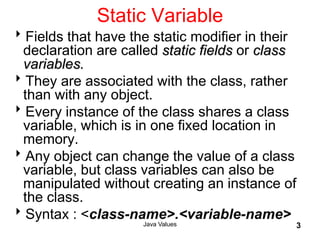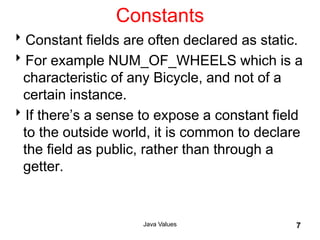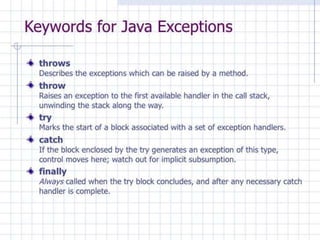Statics in java | Constructors | Exceptions in Java | String in java| class 3
- 1. Java Class 4 “Code is like humor. When you have to explain it, it’s bad.” •Statics in java •Constructors •Exceptions in Java •String in java
- 2. Java Values 2 What is Static Keyword ? The static keyword in Java is used for memory management mainly. We can apply static keyword with variables, methods, blocks and nested classes. The static keyword belongs to the class than an instance of the class. Variable (also known as a class variable) Method (also known as a class method) Block Nested class
- 3. Java Values 3 Static Variable Fields that have the static modifier in their declaration are called static fields or class variables. They are associated with the class, rather than with any object. Every instance of the class shares a class variable, which is in one fixed location in memory. Any object can change the value of a class variable, but class variables can also be manipulated without creating an instance of the class. Syntax : <class-name>.<variable-name>
- 4. Static methods The Java programming language supports static methods as well as static variables. main method is static , since it must be accessible for an application to run , before any instantiation takes place. Static methods, which have the static modifier in their declarations, should be invoked with the class name, without the need for creating an instance of the class, as in ex. ClassName.methodName(args) Java Values 4
- 5. Static methods A common use for static methods is to access static fields. For example, we could add a static method to the Bicycle class to access the static field numberOfBicycles : Java Values 5 public static int getNumberOfBicycles() { return numberOfBicycles; }
- 6. Static methods Not all combinations of instance and class variables and methods are allowed: • Instance methods can access instance variables and instance methods directly. • Instance methods can access class variables and class methods directly. • Class methods can access class variables and class methods directly. • Class methods cannot access instance variables or instance methods directly—they must use an object reference. Also, class methods cannot use the this or super keywords, as there is no instance to refer to. Java Values 6
- 7. Constants Constant fields are often declared as static. For example NUM_OF_WHEELS which is a characteristic of any Bicycle, and not of a certain instance. If there’s a sense to expose a constant field to the outside world, it is common to declare the field as public, rather than through a getter. Java Values 7
- 8. Singleton pattern Restricting the instantiation of a certain class to exactly one object. This is useful when exactly one object is needed to coordinate actions across the system. A singleton object is accessible globally using a static method. Java Values 8
- 9. Singleton Java Values 9 public class Controller { private static Controller instance = null; private Controller () { ... } public static Controller getInstance() { if (instance == null) { instance = new Controller (); } return instance; } ... } * Not thread-safe Notice the private constructor
- 10. A static block The static block, is a block of statement inside a Java class that will be executed when a class is first loaded in to the JVM. A static block helps to initialize the static data members, just like constructors help to initialize instance members. public class Controller { private static Controller instance; static { instance = new Controller (); } private Controller () { } public static Controller getInstance() { return instance; } } Java Values 10
- 11. Example of static EX: 1 class A2{ static{ System.out.println("static block is invoked"); } public static void main(String args []){ System.out.println("Hello main"); } } output : ? Java Values 11 EX: 2 class TestOuter1{ static int data=30; static class Inner{ void msg(){ System.out.println("data is : "+data); } } public static void main(String args[]){ TestOuter1.Inobj=new TestOuter1.Inner(); obj.msg(); } }
- 12. Java static nested class A static class i.e. created inside a class is called static nested class in java. It cannot access non- static data members and methods. It can be accessed by outer class name. It can access static data members of outer class including private. Static nested class cannot access non-static (instance) data member or method. For Example Refer previous slide EX:2 output? Java Values 12
- 13. What is Constructors ? In Java, a constructor is a block of codes similar to the method. It is called when an instance of the class is created. At the time of calling constructor, memory for the object is allocated in the memory. It is a special type of method which is used to initialize the object. Every time an object is created using the new() keyword, at least one constructor is called. Java Values 13
- 14. Rules for creating constructor There are two rules defined for the constructor. Constructor name must be the same as its class name A Constructor must have no explicit return type. A Java constructor cannot be abstract, static, final, and synchronized class Bike1{ Bike1(){ //creating a default constructor System.out.println("Bike is created"); } public static void main(String args[]){ Bike1 b=new Bike1(); //calling a default constructor } } Java Values 14
- 15. Type of Constructors There are two types of constructors in Java: 1. Default constructor (no-arg constructor) 2. Parameterized constructor If there is no constructor in a class, compiler automatically creates a default constructor. Java Values 15
- 16. class Student4{ int id; // default value 0 String name; //default value null // if we not pass the int I and string n value it will give default value Student4(int i,String n){ //creating a parameterized constructor id = i; name = n; } //method to display the values void display(){System.out.println(id+" "+name);} public static void main(String args[]){ //creating objects and passing values Student4 s1 = new Student4(111,"Karan"); Student4 s2 = new Student4(222,"Aryan"); //calling method to display the values of object s1.display(); s2.display(); } } Java Values 16 Output:?
- 17. Constructor Chaining Calling a constructor from the another constructor of same class is known as Constructor chaining.. Java Values 17
- 18. This and Super constructors this() and super() are used to call constructors explicitly. 1. Using this() you can call the current class’s constructor 2. Using super() you can call the constructor of the super class. Java Values 18
- 19. class A { public int x, y; public A(int x, int y) { this.x = x; this.y = y; } } class B extends A { public int x, y; public B() { this(0, 0); } public B(int x, int y) { super(x + 1, y + 1); // calls parent class constructor this.x = x; this.y = y; } Java Values 19 public void print() { System.out.println("Base class : {" + x + ", " + y + "}"); System.out.println("Super class : {" + super.x + ", " + super.y + "}"); } } class Point { public static void main(String[] args) { B obj = new B(); obj.print(); obj = new B(1, 2); obj.print(); } } ? Answer
- 20. Constructors for Enumerated Data Types enum Car { lamborghini(900),tata(2),audi(50),fiat(15),honda(12); //Enum datatype private int price; Car(int p) { price = p; } int getPrice() { return price; } } public class Main { public static void main(String args[]){ System.out.println("All car prices:"); for (Car c : Car.values()) System.out.println( c + " costs " + c.getPrice() + " thousand dollars."); } } Java Values 20
- 21. Java Values 21
- 22. Exception ?? Java Values 22Exception is an abnormal condition.
- 23. What ? Why ? How? In Java, an exception is an event that disrupts the normal flow of the program. It is an object which is thrown at runtime. Exception Handling is a mechanism to handle runtime errors such as ClassNotFoundException, IOException, SQLException, RemoteException, etc. The core advantage of exception handling is to maintain the normal flow of the application. An exception normally disrupts the normal flow of the application that is why we use exception handling. Java Values 23
- 24. API hierarchy for Exceptions Java Values 24 Parent class
- 25. Types of Exceptions Java Values 25 Java Values.com
- 26. Keywords in Exception API Java Values 26
- 27. Java Values 27
- 28. Catching Exceptions The try-catch Statements ● Syntax: try { <code to be monitored for exceptions> } catch (<ExceptionType1> <ObjName>) { <handler if ExceptionType1 occurs> } ... } catch (<ExceptionTypeN> <ObjName>) { <handler if ExceptionTypeN occurs> } finally { <code to be executed before the try block ends> } Java Values 28
- 29. Throwing Exceptions The throw Keyword ● Java allows you to throw exceptions (generate exceptions) ex. throw <exception object>; ● An exception you throw is an object – You have to create an exception object in the same way you create any other object ● Example: throw new ArithmeticException(“testing...”); class TestHateString { public static void main(String args[]) { String input = "invalid input"; try { if (input.equals("invalid input")) { throw new HateStringExp(); } System.out.println("Accept string."); Java Values 29 } catch (HateStringExp e) { System.out.println("Hate string!”); } } }
- 30. Example 2 class InvalidAgeException extends Exception{ InvalidAgeException(String s){ super(s); } } class TestCustomException1{ static void validate(int age)throws InvalidAgeException{ if(age<18) throw new InvalidAgeException("not valid"); else System.out.println("welcome to vote"); } public static void main(String args[]){ try{ validate(13); }catch(Exception m){System.out.println("Exception occured: "+m);} System.out.println("rest of the code..."); } } Java Values 30 Output:?
- 31. String in Java Java Values 31 Java Values
- 32. Strings String is a sequence of characters placed in double quote(“ ”). //(“JAVA”) Strings are constant , their values cannot be changed in the same memory after they are created. There are two ways to create String object: 1)By string literal. 2)By new keyword. Java Values 32
- 33. String Creation By string literal: For Example: String s1=“welcome"; String s2=“welcome”; //no new object will be created Java Values 33
- 34. By new keyword:- For Example: String s=new String(“Sachin"); String s=newString(“SachinTendulkar"); //create two objects and one reference variable Java Values 34
- 35. Immutability In java, string objects are immutable. Immutable simply means unmodifiable or unchangeable. Once string object is created its data or state can't be changed but a new string object is created. Advantage of immutability is Use of less memory Disadvantages of Immutability: Less efficient — you need to create a new string and throw away the old one even for small changes Java Values 35
- 36. String word1 = "Java"; String word2 = word1; Word1 Java word2 OK Java Values 36 String word1 = “Java"; String word2 =new String(word1); Word1 Java Word2 Java Less efficient: wastes memory
- 37. String Methods substring(int begin): Returns substring from begin index to end of the String. Example: String s=“nacre”; System.out.println(s.substring(2));//cre equals(): To perform content comparision where case is important. Example: String s=“java”; System.out.println(s.equals(“java”));//true concat(): Adding two strings we use this method Example: String s=“nacre”; s= s.concat(“software”); System.out.println(s);// nacresoftware Java Values 37
- 38. length() , charAt() int length(); Returns the number of characters in the string char charAt(i); Returns the char at position i. Character positions in strings are numbered starting from 0 – just like arrays. Returns: “Problem".length(); 7 “Window”. charAt (2); ’n' Java Values 38
- 39. StringBuffer, StringBuilder StringTokenizer Java Values 39 Java values All These classes are final and subclass of Serializable.
- 40. Limitation of String in Java ? What is mutable string? A string that can be modified or changed is known as mutable string. StringBuffer and StringBuilder classes are used for creating mutable string. Differences between String and StringBuffer in java? Main difference between String and StringBuffer is String is immutable while StringBuffer is mutable Java Values 40
- 41. StringBuffer StringBuffer is a synchronized and allows us to mutate the string. StringBuffer has many utility methods to manipulate the string. This is more useful when using in multithreaded environment. Always modified in same memory location. Methods: 1. Append 2. Insert 3.Delete 4.Reverse 5.Replacing Character at given index Java Values 41
- 42. StringBuilder StringBuilder is the same as the StringBuffer class. The StringBuilder class is not synchronized and hence in a single threaded environment, the overhead is less than using a StringBuffer. public class Test { public static void main(String[] args) { String str = “Java"; StringBuffer sbr = new StringBuffer(str); sbr.reverse(); System.out.println(sbr); // conversion from String object to StringBuilder StringBuilder sbl = new StringBuilder(str); sbl.append(“Values"); System.out.println(sbl); } } Java Values 42 Output?
- 43. StringTokenizer A token is a portion of a string that is separated from another portion of that string by one or more chosen characters (called delimiters). The StringTokenizer class contained in the java.util package can be used to break a string into separate tokens. This is particularly useful in those situations in which we want to read and process one token at a time; the BufferedReader class does not have a method to read one token at a time. Java Values 43
- 44. Java Values 44 Java Values “Hello world welcome to Java Values” String Tokenizer Token Hello world welcome to Java Values
- 45. Java Values 45
- 46. Java Values 46
- 47. Statics variable, Method, block, nested class Constructors default ,no-arg, parameterize Exceptions in Java Checked –unchecked, exception, error , try-catch-finally-throw-throws, customize exception String String –Stringbuffer-StringBuilder-String Tokenizer Q & A ??? Java Values 47 For engineering project or live project internship please contact us Mindlabz Software Technology











![Example of static
EX: 1
class A2{
static{
System.out.println("static block is
invoked");
}
public static void main(String args
[]){
System.out.println("Hello main");
}
}
output : ?
Java Values 11
EX: 2
class TestOuter1{
static int data=30;
static class Inner{
void msg(){
System.out.println("data is : "+data);
}
}
public static void main(String args[]){
TestOuter1.Inobj=new TestOuter1.Inner();
obj.msg();
}
}](https://image.slidesharecdn.com/day3-200719122053/85/Statics-in-java-Constructors-Exceptions-in-Java-String-in-java-class-3-11-320.jpg)


![Rules for creating constructor
There are two rules defined for the constructor.
Constructor name must be the same as its class
name
A Constructor must have no explicit return type.
A Java constructor cannot be abstract, static, final,
and synchronized
class Bike1{
Bike1(){ //creating a default constructor
System.out.println("Bike is created");
}
public static void main(String args[]){
Bike1 b=new Bike1(); //calling a default constructor
}
}
Java Values 14](https://image.slidesharecdn.com/day3-200719122053/85/Statics-in-java-Constructors-Exceptions-in-Java-String-in-java-class-3-14-320.jpg)

![class Student4{
int id; // default value 0
String name; //default value null
// if we not pass the int I and string n value it will give default value
Student4(int i,String n){ //creating a parameterized constructor
id = i;
name = n;
}
//method to display the values
void display(){System.out.println(id+" "+name);}
public static void main(String args[]){
//creating objects and passing values
Student4 s1 = new Student4(111,"Karan");
Student4 s2 = new Student4(222,"Aryan");
//calling method to display the values of object
s1.display();
s2.display();
}
}
Java Values 16
Output:?](https://image.slidesharecdn.com/day3-200719122053/85/Statics-in-java-Constructors-Exceptions-in-Java-String-in-java-class-3-16-320.jpg)


![class A
{
public int x, y;
public A(int x, int y) {
this.x = x; this.y = y;
}
}
class B extends A {
public int x, y;
public B() {
this(0, 0);
}
public B(int x, int y) {
super(x + 1, y + 1); // calls parent
class constructor
this.x = x;
this.y = y;
}
Java Values 19
public void print() {
System.out.println("Base class : {" + x + ", "
+ y + "}");
System.out.println("Super class : {" +
super.x + ", " + super.y + "}");
}
}
class Point
{
public static void main(String[] args) {
B obj = new B();
obj.print();
obj = new B(1, 2);
obj.print();
}
}
? Answer](https://image.slidesharecdn.com/day3-200719122053/85/Statics-in-java-Constructors-Exceptions-in-Java-String-in-java-class-3-19-320.jpg)
![Constructors for Enumerated Data Types
enum Car {
lamborghini(900),tata(2),audi(50),fiat(15),honda(12); //Enum datatype
private int price;
Car(int p) {
price = p; }
int getPrice() {
return price;
}
}
public class Main {
public static void main(String args[]){
System.out.println("All car prices:");
for (Car c : Car.values())
System.out.println( c + " costs " + c.getPrice() + " thousand dollars.");
}
} Java Values 20](https://image.slidesharecdn.com/day3-200719122053/85/Statics-in-java-Constructors-Exceptions-in-Java-String-in-java-class-3-20-320.jpg)








![Throwing Exceptions
The throw Keyword
● Java allows you to throw exceptions (generate exceptions)
ex. throw <exception object>;
● An exception you throw is an object
– You have to create an exception object in the same way you create
any other object
● Example:
throw new ArithmeticException(“testing...”);
class TestHateString {
public static void main(String args[]) {
String input = "invalid input";
try {
if (input.equals("invalid input")) {
throw new HateStringExp();
}
System.out.println("Accept string.");
Java Values 29
} catch (HateStringExp e) {
System.out.println("Hate string!”);
}
}
}](https://image.slidesharecdn.com/day3-200719122053/85/Statics-in-java-Constructors-Exceptions-in-Java-String-in-java-class-3-29-320.jpg)
![Example 2
class InvalidAgeException extends Exception{
InvalidAgeException(String s){
super(s);
}
}
class TestCustomException1{
static void validate(int age)throws InvalidAgeException{
if(age<18)
throw new InvalidAgeException("not valid");
else
System.out.println("welcome to vote");
}
public static void main(String args[]){
try{
validate(13);
}catch(Exception m){System.out.println("Exception occured: "+m);}
System.out.println("rest of the code...");
}
}
Java Values 30
Output:?](https://image.slidesharecdn.com/day3-200719122053/85/Statics-in-java-Constructors-Exceptions-in-Java-String-in-java-class-3-30-320.jpg)











![StringBuilder
StringBuilder is the same as the StringBuffer class.
The StringBuilder class is not synchronized and
hence in a single threaded environment, the
overhead is less than using a StringBuffer.
public class Test
{
public static void main(String[] args)
{
String str = “Java";
StringBuffer sbr = new StringBuffer(str);
sbr.reverse();
System.out.println(sbr);
// conversion from String object to StringBuilder
StringBuilder sbl = new StringBuilder(str);
sbl.append(“Values");
System.out.println(sbl);
}
}
Java Values 42
Output?](https://image.slidesharecdn.com/day3-200719122053/85/Statics-in-java-Constructors-Exceptions-in-Java-String-in-java-class-3-42-320.jpg)




